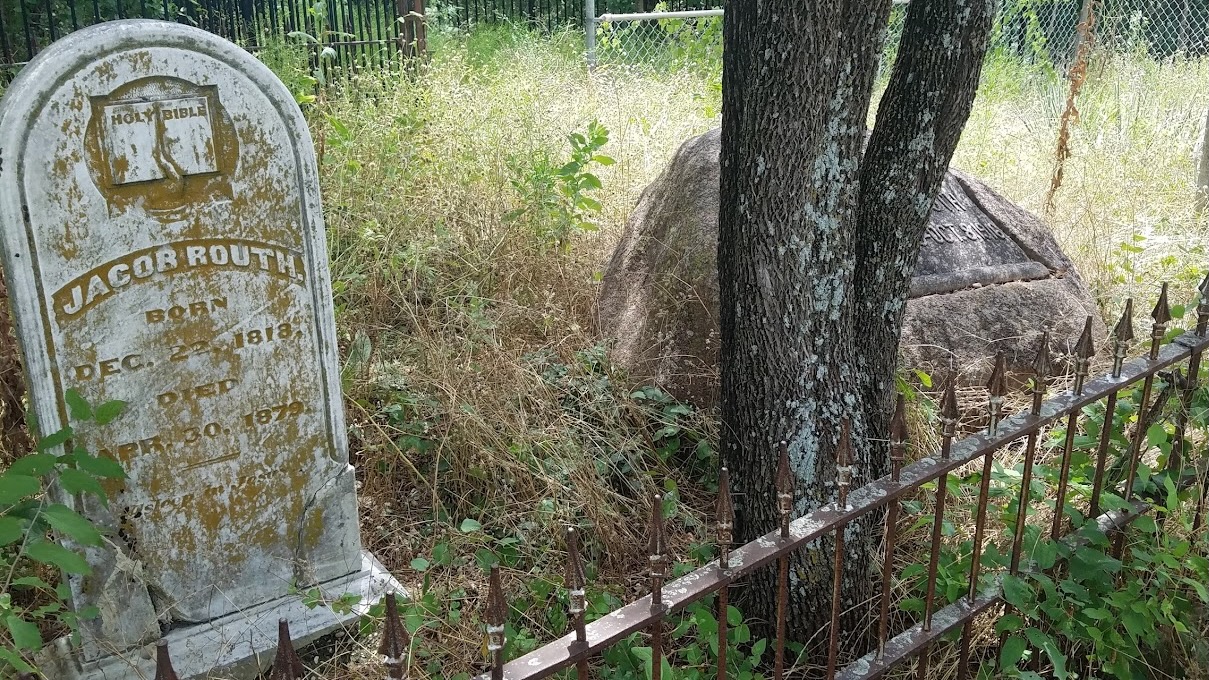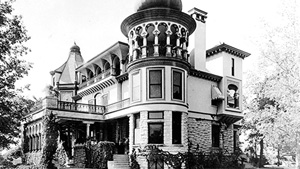
By Frances James (1922 – 2019)
Routh Cemetery, also known as Spring Creek Cemetery
The two cemeteries known as the Routh Cemeteries are located about fifteen miles northeast of the Dallas County Court House. Situated east of Central Expressway (US Highway 75), south of Renner Road, and north of Glenville Avenue, they are located a short distance east of the DART line, near a paved walking trail and the Spring Creek Nature Area. The cemeteries are within the 640 acre John U. Vance Survey. Although Peter Colonist Vance’s land was patented in Collin County, he probably had to pay taxes in Dallas as well as Collin County since one-sixth of his land was in Dallas County.
Missouri native John U. Vance (1811- 18 ) was a Cumberland Presbyterian preacher who with his wife Martha and their nine children moved to Illinois before coming to Texas prior to 1848. Several members of the Vance family came to Texas, including the sixty-five year old patriarch, Thomas, a carpenter and his other sons, Charles King, a carpenter, James C., a farmer, and Fountain, a surveyor who had practiced law before coming to Texas. All settled on adjoining tracts of land south of where Plano later was founded. Fountain was elected the first Collin County Surveyor and was the Collin County Chief Justice in 1864 and 1865.
The Routh brothers and sisters, Jacob, George Washington, Joseph, Thomas Jefferson, and Elizabeth Routh Thomas were cousins of the Vances. Upon arrival in Texas in the fall of 1851, Jacob Routh (1818-1879) acquired the 640 acre John Vance Survey. While here, he also made arrangements for land for his brother Joseph and his family. Jacob was still single at the age of thirty-three. Then he returned to Tennessee to bring his mother, Elizabeth Mashman Routh (1788-1852), and his sister, Elizabeth Thomas back to Texas. Although married, Elizabeth left her husband in Tennessee and came with her brother at this time in order to help care for their crippled mother. There was also an adopted niece, Rachel Elizabeth Mann who came with them. Jacob Routh brought Ann, a slave, with them. Ann cared for the crippled mother until she died. This wagon train consisted of 6 four-horse wagons and a carriage and took forty-five days to travel the nearly 1000 miles to Texas. Jacob kept a diary and close tabs on all expenses throughout the trip.
There is a wonderful history of this large group of inter – related family members who came from the same area of Tennessee to Texas. They were involved in establishing a school, a church, a cemetery, and a store in the immediate area. The first home was built near Spring Creek, on the road between Dallas and McKinney. Where Renner Road intersects with what is now Plano Road, Jacob started a small general store and had goods from Galveston, Philadelphia, and Cleveland shipped by water and freight wagon.
Jacob Routh had been ordained a Baptist preacher in Tennessee. He was also licensed to preach to his thinly scattered neighbors in Texas. He was one of the first ministers ordained in the Baptist religion in North Texas. Jacob was disliked by some of his white neighbors because he also preached to the colored people. He helped them organize churches, and even recommended to the Plano Baptist Church that they help Negro preachers set up schools for the Negro children.
At the time Jacob Routh purchased the land in the Vance Survey, there were already three known gravesites on this site. One, with a headstone still legible, was for Nancy Beverly, the wife of William Beverly. She had died on June 16, 1851. One was for William Klepper, the seven year old son of Peter Colonist Nancy Beverly Klepper and Joseph Klepper. The other was the grave of a child of immigrants, who died while the family camped along Spring Creek. The flat rocks that marked this site are now disintegrated. At the urging of neighbors, Jacob set aside this one acre site for a cemetery. In 1852, one of the very first burials was that of Elizabeth Mashman Routh, the mother ofthe large Routh family, she died just a year after arriving in Texas.
Thomas Jefferson Routh came to Texas in 1850 with his wife Nancy Hoskins and was already living on the Thomas Vance Survey east of Jacob, died in 1855 and lies buried in an unmarked grave. Joseph Routh (1822-1856) Jacob’s brother, who had married Serepta Campbell in 1854, was buried in the Routh Cemetery near his mother and brother.
Jacob Routh married Lodemia Campbell (1833-1916) in 1853. Lodemia was the daughter of Robert F. Campbell and sister of Serepta. Jacob and Lodemia lived in a log cabin that had been built by John Vance. In 1860, Jacob started to build a large home, but with the coming of the Civil War construction progress was slowed for several years. It was finally completed in 1865.
This house was visible to the passengers on the Houston and Texas Central Railroad as Jacob had sold a 200 foot strip of land for Right of Way in 1873, very near the house. Later the riders on the interurban could see this landmark as they passed by. The one hundred year old structure was destroyed by vandals who set it on fire in September 1965.
Jacob died of tuberculosis in 1879 and is buried in a separate, small, fenced cemetery plot several hundred yards north of the one acre cemetery just south of Spring Creek. At this special site, along with Jacob, are his wife Lodemia Ann Campbell Routh, and two unmarried daughters Rose (1874-1954) and Clara Routh (1876-1962). Clara was the last surviving member of Jacob and Lodemia’s family, and cared for the family property until her death. A special note should be made of the grave markers for Frances, Fluffie (1918-1937), Katie, Sharon, Rennett, and Theta. These three small stones outside the iron fence mark the graves of the horses, a cat and dogs that had belonged to Rose and Clara.
As mentioned above, the first marked gravesite in the Routh cemetery is that of Illinois native Nancy De Lozier Beverly (1806-1851) wife of William Beverly. They had married in 1837 and came to Texas in 1846 with their children. Nancy was the mother of nine children when she died, seven sons and two daughters. Five of the sons were killed in one year, 1864, while fighting for the Confederacy. William was County Commissioner in Collin County in 1852, 1854, and 1856. He later married Rebecca Crownover and they had five children. He died and was buried in the old Plano Cemetery in 1887. One of the surviving sons was John Beverly, who became a well known, vital, circuit riding Methodist preacher. John established several of the early Methodist congregations in Dallas and Collin Counties.
In the one acre cemetery are the graves of seven members of the Skiles family. This large family consisted of Jacob (1802-1880) and Sarah (1809-1896) Skiles and their seven sons and daughters who came to Texas from Kentucky with about thirty other families in the fall of 1852.
Charles Skiles (1831-1880) took a wagon load of com to Dallas in February 1880. He was unprotected along the trail when a blue norther came in and he later developed pneumonia from exposure on the long trip and died. He is buried in the Routh Cemetery. His wife Martha Alice Rowland Skiles (1837-1899) is buried beside him. One of their sons, Dickey, lived only a few hours in 1861 and is buried near his parents as is an infant daughter, Lara, who was six months old when she died in 1864.
Georgia Skiles (1876-1895) was preparing for her wedding when she died of typhoid fever in June. Jacob Clemons (1802-1880) and Sarah Elizabeth (Alice) Moore (1809-1896) Skiles are nearby. There are other members of this large family also interred within the site. One son, Jacob Clemons Skiles, married the orphaned niece of Jacob Routh, Rachel Elizabeth Mann in Collin County on September 11, 1861. They had a large family and eventually settled in Somervell County where Rachel was buried in 1890 in the Nancy Routh Cemetery located about seven miles west of Glen Rose on US Highway 67.
Robert Montgomery (1804-1881) and Mary A. Kerley (1811-1875) Rowland were married in Tennessee in 1829. They came to Dallas in 1854 with their nine children. They are both buried in the cemetery along with a son, a daughter, and several grandchildren who died young.
The Robert Fleming Campbell family left Tennessee in the large wagon train with some of the above families in 1851. Robert had been married before to Jane David who had died in 1841 in Tennessee. Robert Campbell brought his six children as well as his new wife, Mary Hoffer, whom he married in 1849 and their infant son. They camped out on the Routh farm until they could procure their own land and build a shelter. The first member of this family to be buried in the Routh Cemetery was Henry K. Campbell who died at age sixteen years. He was the infant brought in his mother’s arms on the long journey. The second Campbell family member to be buried at the Routh Cemetery was James W. Campbell (1837-1875). He was a teenager when he came to Texas. Another member of this family to be buried here was Serepta Campbell Routh Miller (1836-1922). She had first married Joseph Routh in 1854. After Joseph died in 1856, she married a man named Miller. Robert Fleming Campbell died in November of 1881.
It was just recently that the grave markers for Doctor J.B. Baird (1815-1882) his wife Agnes Sloss (1821-1897) and Thomas Sloss (1844-1920) Baird were discovered in the Routh Cemetery by his descendants. Dr. Baird had attended medical school at Louisville, Kentucky, and married his cousin, Agnes, in 1841. They migrated to Lamar County in 1847 and after several moves settled in Breckenridge, Dallas County. Their daughter Prudence (1843-1869) married Captain William H. Harris in 1867 and was buried at Routh when she died two years later from complications of childbirth. Her son, Johnny lived about a year and is buried next to his mother. The Baird’s son Thomas Sloss Baird (1845-1920) who assisted his father in managing a drug store in the Little Elm Community is buried here. Angie Baird (1847-1870) another daughter who had married Jesse Chinn in 1869 died without children. Descendant, Dr. William David Baird (1912-2006), followed up and compiled his family’s history which includes photographs and the family Bible. He was most excited when he found the final resting place of so many family members.
For many years Henry Warren Coit, who was descended from the Rouths on his mother’s side, was the self appointed caretaker of this site. More recently other descendants, who have family buried at this site, have established the Routh Cemetery Association with an endowment fund. It provides for the continual maintenance of this site which is the final resting place for the nearly two hundred settlers, ninety-three of whom are identified.
These are the pioneers who came to this area of Dallas County and helped develop the community now called Richardson.
Frances James, “Dallas County History – From the Ground Up, Book II,” 2009.
Get future posts by email.


